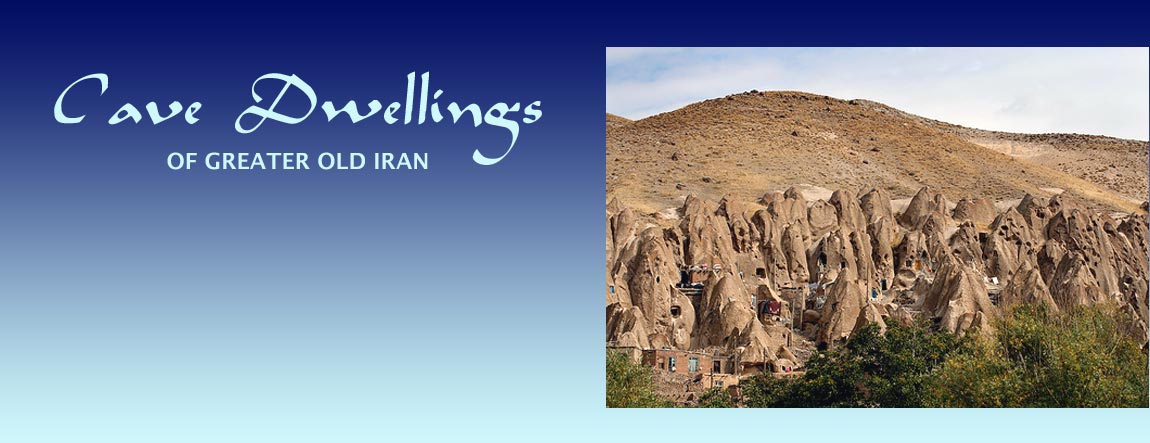
Contents
|
Further reading:
Jamsheedi Vara
The concept of cave dwelling can be found in one interpretation of the Zoroastrian scriptures, the Avesta. The first mention and description of a planned Aryan township in the Avesta is the Jamsheedi Vara. Some authors have translated the word 'vara' as 'cave' and see the vara as a network of caves. Another interpretation is that the Vara is an enclosed or closely grouped structures such as traditional Pamiri settlements.
Cave Dwellings & Troglodytes of Old Iran
While the plains of Mesopotamia are often touted as the cradle of civilization, early Stone Age hominines/hominids* (genus Homo - hereafter called hominids) left scant evidence of their presence in the plains. It is in the foothill of the Zagros Mountains bordering Mesopotamia to the east and the north - or for that matter the hills of Greater Aryana (Iran, Central Asia, Pakistan, Azerbaijan, Eastern Iraq, Kurdistan and Eastern Turkey) as a whole - that we find evidence of what early Stone Age hominids left behind in caves and rock shelters. Prehistoric cave dwelling have been found throughout the region of Greater Aryana from Shanidar in Kurdistan to Teshik-Tash in Uzbekistan and the Sel'ungur Cave in Kyrgyzstan . The region is also home to present-day cave dwelling communities whose residents have been given the technical name troglodytes.
[* Hominine (also spelt hominin): primate with upright stance: a primate with a two-legged gait, relatively small face and teeth, and large brain. Hominines include human beings and their most direct ancestors. Hominid: member of primate family including humans - a primate belonging to a family of which the modern human being is the only species still in existence.]
Troglodyte means cave dweller: somebody living in a cave, especially somebody who belonged to a prehistoric cave-dwelling community. Troglodyte also means somebody living in seclusion.
Some cave dwellings are classified as rock-shelters or shallow caves. Rock-shelters (also called rock-houses, crepuscular caves, and abri) are often found at the base of bluffs, cliffs and waterfalls. The word 'karst' is also found associated with cave dwellings. A karst is a limestone region or landscape characterized by caves, fissures, and underground streams. Some caves that contain evidence of habitation have been enlarged, modified and even carved out by hominids or humans.
In Iran, caves are called 'gar' (we wonder if there is an etymological connection with 'var' (cf. vara). In Kurdistan, caves are called shkaft.
Earliest Known Cave Dwellings in the Old Aryan Lands
Our understanding of the earliest cave dwellings of Old Iran is hostage to the extent of research and archaeological explorations that have been conducted given the uncertain political climate that has extended from the Tigris to the Jaxartes rivers.
Within the Iranian plateau itself, since the Zagros highlands have been subject to more Stone Age cave dwelling focused research and investigation than have the Central Asian mountains, there is consequently more information related to Zagros cave dwellings available. However, this does not mean that early troglodytes were concentrated more in Zagros than elsewhere in Old Iran. Nor does it mean that during Palaeolithic (Old Stone Age) times, cave dwellings outnumbered plain/open-air dwellings (the latter outnumber the former) for many cave dwellings might have served as temporary or seasonal shelters for hunters or nomads. The nature of our topic leads us in the direction of the hills of Old Iran rather than the plains - since hills are where the preponderance of caves are found.
In Central Asia, the majority of early Old Stone Age (Lower Palaeolithic period) sites are located in the mountain and hill regions emanating out of the Pamirs - be they in Tajikistan, Uzbekistan, Afghanistan, Kazakhstan or Kyrgyzstan.
Evidence of the use of caves as dwellings by early humans and their forbearers goes back to the Stone Age.
 |
| Paleolithic & caves sites of greater old Iran © K. E. Eduljee |
» Top
Further reading:
|

